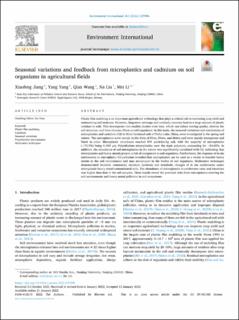| dc.contributor.author | Jiang, Xiaofeng | |
| dc.contributor.author | Yang, Yang | |
| dc.contributor.author | Wang, Qian | |
| dc.contributor.author | Liu, Na | |
| dc.contributor.author | Li, Mei | |
| dc.date.accessioned | 2023-09-20T09:06:50Z | |
| dc.date.available | 2023-09-20T09:06:50Z | |
| dc.date.created | 2022-09-15T08:35:21Z | |
| dc.date.issued | 2022 | |
| dc.identifier.citation | Environment International. 2022, 161 . | en_US |
| dc.identifier.issn | 0160-4120 | |
| dc.identifier.uri | https://hdl.handle.net/11250/3090731 | |
| dc.description.abstract | Plastic film mulching is an important agricultural technology that plays a critical role in increasing crop yield and maintaining soil moisture. However, long-term coverage and untimely recovery lead to a large amount of plastic residues in soils. This decomposes into smaller plastics over time, which can reduce sowing quality, destroy the soil structure, and have adverse effects on soil organisms. In this study, the seasonal variations and correlations of microplastics and cadmium (Cd) in Wuxi farmland soils of Taihu Lake, China, were investigated in the spring and winter. The microplastics were mainly in the form of films, fibers, and debris and were mainly transparent and black in color. Microplastic abundance reached 890 particles/kg soil, with the majority of microplastics (>72.5%) being 0–500 μm. Polyethylene microplastics were the main polymers, accounting for >54.65%. In addition, the abundance of soil microplastics in the winter was significantly correlated with Cd, indicating that microplastics and heavy metals present a risk of coexposure to soil organisms. Furthermore, the response of in situ earthworms to microplastic–Cd pollution revealed that microplastics can be used as a vector to transfer heavy metals in the soil environment and may accumulate in the bodies of soil organisms. Multiomics techniques demonstrated bacterial community structure dysbiosis and metabolic changes of in situ earthworms under microplastic heavy metal-contaminated soils. The abundance of microplastics in earthworm casts and intestines was higher than that in the soil samples. These results reveal the potential risks from microplastics entering the soil environment and heavy metal pollution in soil ecosystems. | en_US |
| dc.language.iso | eng | en_US |
| dc.relation.uri | https://reader.elsevier.com/reader/sd/pii/S0160412022000228?token=B56C2152BBEFFCFC0D1AE2557A3333013454B73D2037E3767ED7A2AF20CCF007C9E33E267F63B340908DB6B0FF4630FC&originRegion=eu-west-1&originCreation | |
| dc.rights | Attribution-NonCommercial-NoDerivatives 4.0 Internasjonal | * |
| dc.rights.uri | http://creativecommons.org/licenses/by-nc-nd/4.0/deed.no | * |
| dc.title | Seasonal variations and feedback from microplastics and cadmium on soil organisms in agricultural fields | en_US |
| dc.title.alternative | Seasonal variations and feedback from microplastics and cadmium on soil organisms in agricultural fields | en_US |
| dc.type | Journal article | en_US |
| dc.type | Peer reviewed | en_US |
| dc.rights.holder | © 2022 The Authors | en_US |
| dc.description.version | publishedVersion | en_US |
| cristin.ispublished | true | |
| cristin.fulltext | original | |
| cristin.qualitycode | 1 | |
| dc.identifier.doi | 10.1016/j.envint.2022.107096 | |
| dc.identifier.cristin | 2051836 | |
| dc.source.journal | Environment International | en_US |
| dc.source.volume | 161 | en_US |
| dc.source.pagenumber | 11 | en_US |
| dc.relation.project | Andre: Nanjing University Innovation & Creative Prog No..CXCY19-61 | en_US |
| dc.relation.project | Andre: S&T Support Program of Jiangsu Province No. BE2016736 | en_US |
| dc.relation.project | Andre: National NSF of China (No. 41773115, 41571468) | en_US |

